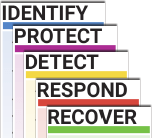
With the number of cyber breaches, threats and malicious attacks ever-growing, it can seem like an overwhelming, monumental task to ensure all of your cybersecurity bases are covered. From malware, phishing and spoofing to identity-based attacks, password hacking and more, the cyber world can be a dangerous place for any organization. Fortunately, if you are looking for cost-effective ways to protect your data, networks and people, there are a few things you can do today to help provide peace of mind that you, your data and your network are protected.
At TREBRON IT & Cybersecurity, we understand that achieving the ideal state for a cybersecurity program can be daunting and expensive. That’s why we’re working with customers to simplify the process and help IT managers better secure their networks, data and people. Keep reading to learn more about the five things you can do to maximize your cybersecurity today.
Perform Regular Security Audits
Aligning with a cybersecurity framework is an ideal way to protect your information systems and critical infrastructure in the event of a malicious attack. At TREBRON, we often see IT teams take a scattered approach to cybersecurity without a specific plan in place. However, by following a cybersecurity framework, or a collection of best practices, we can help you identify any areas within your company that are most vulnerable and then implement procedures to reduce those risks.
We offer audits and risk assessments that help organizations develop a plan to come into alignment with the NIST framework – one of the best-known cybersecurity frameworks today. We can review and document your current practices, evaluate your risks and compare your current infrastructure with this cybersecurity framework to identify areas in need of improvement.
Patch and Update Software
One of the most fundamental steps to cybersecurity but also the most overlooked, patching and updating software on a regular basis can help to reduce the risk of a cyber threat or attack. In many cases, IT teams remove this from their priority list, leaving their organizations vulnerable to breaches. However, these patches and updates are necessary to keep your devices and systems running smoothly while lowering security vulnerabilities as well.
We can work with you to identify the tools that are available that can automate patching across various platforms. By addressing any vulnerabilities now, we can help block the open doors in your software to protect your devices, networks and infrastructure from attacks. Our team is happy to speak with you about your existing software to determine if any patches are available for your specific system.
Perform Regular Backups of Critical Data
Another overlooked step to ensuring incident preparedness is to perform regular backups of critical data, which can be done relatively inexpensively. We recommend implementing an immutable, or unchangeable, backup that cannot be tampered with or altered for a present period of time. This helps to ensure your organization has a secure backup should you fall victim to a malicious event or ransomware attack.
Our team can provide a backup and recovery audit to provide peace of mind that your organization is protected. We can review your past backups and results, evaluate your backup processes and identify your system architecture. We will also recommend any areas in which we find room for improvement to ensure your data, people and systems are prepared in the event of a threat.
Develop Incident Response Plans
Another effective way to boost your organization’s cybersecurity preparedness today is to develop incident response plans. A cornerstone of any cybersecurity program, incident response plans allow you to quickly and effectively respond to security incidents to minimize damage, avoid high costs, improve recovery time and restore operations as soon as possible. Not only is it important to document these plans and regularly update them, but organizations should also conduct regular tabletop exercises to ensure everyone knows their roles and is prepared to act.
We can help you develop a plan and direction for specific attack scenarios to help you avoid further damage and reduce recovery time. Without a formal plan in place, your organization may not be able to detect an attack or know what to do to contain it quickly, clean up the aftermath or prevent future attacks.
Control Access to the Network and Critical Data
The most common approach to controlling access to networks and critical data is to implement multi-factor authentication (MFA). At a minimum, organizations should apply MFA to email, VPN, all administrative access and any applications that hold critical data. While it can be daunting to roll out and you will likely experience frustration from your users at first, mainly because it will force some change in your regular login process, we find this period to be very short. And, compared with the long-term cybersecurity benefits, it’s a no-brainer!
At TREBRON, we understand the importance of securing your apps and accounts when it comes to accessing your organization’s sensitive financial data, personal information and more. If you’re looking for ways to keep the right people in and the wrong people out, MFA is a trusted, effective solution that can keep your infrastructure secure.
Ready to Learn More?
Following these top five actions, along with participating in ongoing user cybersecurity education, will put your organization well down the road toward the ideal state of cybersecurity. If you have questions about our cybersecurity solutions or services or you would like to speak to our team about how TREBRON can help you maximize your cybersecurity, contact us today. We look forward to hearing from you and helping you gain peace of mind that you’re protected.

